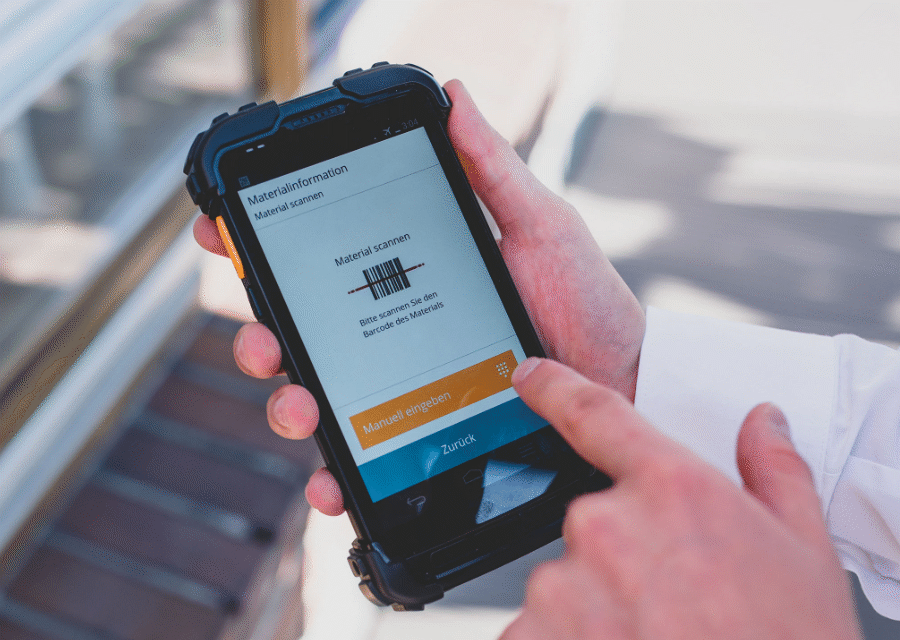In 2016, EWE TEL, based in Oldenburg, took on the challenge of automating and mobilizing its entire warehouse management system. The project was not just about introducing a bin-managed Warehouse Management System (WMS), but also about adapting the organization and guiding employees through the transition.
The Situation in 2016
With the continued broadband expansion in their region, the managers at EWE TEL faced the challenge of reorganizing their warehouse, which contained 45,000 stock items. The goal was to implement a management system that was as simple as possible, yet still secure. They were looking for a bin-managed Warehouse Management System (WMS) in order to automate and mobilize their entire warehouse management. The company had already had very good experiences with "mobile tedis," a mobile solution for order processing on Samsung tablets.

"Previously, there were no mobile goods movements, no real-time transparency of our inventory, and no proper system for stock-taking," reports Karsten Thiem, Group Leader of Operations Control at EWE TEL. "Checking warranties and guarantees was time-consuming, and so was our physical inventory count. All items had to be manually recorded and then entered into SAP on a PC. This was often prone to errors."
Employees to Work Exclusively on Mobile
It was important to the managers to keep SAP as the leading system, while also digitizing and mobilizing all material management processes so that warehouse employees could work exclusively on mobile devices in the future. "We had decided that our IT department should be burdened as little as possible," Thiem explains.
For the software implementation, they only needed to provide the interfaces to SAP; further steps were carried out by the SAP partner. Material movements are connected via web services to ensure EWE's specific SAP logic is maintained. Inventory postings, on the other hand, are enabled via an RFC interface, as this process uses the SAP standard.

Learn everything about modern mobile SAP apps in warehouse and production.
The Decision for a WMS with Ontego
It wasn't just about introducing a WMS, but also about adapting the organization and guiding employees through the transition. At the beginning of 2016, a specifications document for a WMS was created. Initially, this was completely over-scoped for this particular area. As a result, a decision was made to separate material procurement from material management.
With a new specifications document focused solely on warehouse management, the company was ready to tackle the introduction of a WMS. Since EWE TEL had already been using two solutions from commsult—"mobile tedis" and "tedis"—in its field service for four years, discussions about a system expansion could be started quickly. The WMS was developed as an additional module.
Digital Inventory Taking
The plan was to start the go-live parallel to the physical inventory count. This meant the digital inventory process could take place at the same time as the manual one. "That's how we killed several birds with one stone: the necessary inventory taking with permanent storage of all data in SAP, the physical count being carried out directly, and the onboarding of our employees onto the new system," recalls Thiem.
During the first week, an employee from the service provider was on-site in Oldenburg. After a brief introduction and with the help of a comprehensive manual, they were able to begin the inventory process immediately. Thanks to the presence of this product expert, any stumbling blocks could be quickly identified and resolved on the spot.
The inventory process took six weeks. All entries were automatically transferred to SAP, providing all employees with a real-time overview of stock levels and bin locations at all times.
Adapting the Organization and Processes
The implementation of the WMS took place in two phases. In phase one, all processes for goods movement and posting were mapped out. After this phase, work could begin immediately with the new system. In phase two, successive improvements were introduced and the new inventory process was finalized.
"The biggest challenge was adapting the organization and the processes, and then actually living them," says Thiem. "It simply took time before all employees were working exclusively with the mobile devices. The old workflows were ingrained in their minds. But now, the new processes are well-established."
Currently, the mobile solution includes the following components:
- 22 mobile devices from Zebra and Bluebird with Android are in use in the warehouse.
- At a total of 11 locations, all goods management processes are implemented with Ontego.
- 56 field service technicians are on the road with "mobile tedis."
- All employees have offline access to the software and can check inventory, read orders, and make postings. As soon as the mobile device is back online, the data is immediately fed into SAP.

Inventory Effort Halved
"The implementation at this speed and quality exceeded our expectations. The results speak for themselves. Fast implementation with the right quality," summarizes Thiem. EWE TEL benefits above all from the transparency of quantities, real-time stock lists, and the automation of stock reconciliation.
With the WMS, manual efforts—especially during inventory—were significantly reduced. "In the course of our ongoing development, we've had 40 percent more material movements. By using Ontego and mobile data entry, we were able to handle this without additional personnel." He also notes that inventory effort was halved in the very first year.
"Next year, we're even expecting a maximum of two days for the entire inventory count," says Thiem. "For us, the biggest benefit is that all our stock is visible at the bin location level. This allows us to tackle inventory reduction, and the process is continuously digitized and accessible from goods receipt all the way to posting at the customer's site."
The biggest benefits is that we have visibility of all our stock down to specific shelf and bin location. We know exactly where everything is.
— Karsten Thiem, Group Leader of Operations Control at EWE TEL
Finally, in the summer of 2018, "mobile tedis 2.0," the next evolution of the mobile order processing solution, was successfully ported. This makes EWE TEL more independent of the hardware it uses. The new, appealing design was also individually created with the Ontego Designer according to their requirements, just as "tedis" had been before.
Additionally, processing times in mobile tedis 2.0 were further improved: fewer clicks, booking only of goods that are actually on the cart, and the associated further prevention of errors. The support and maintenance effort for the end devices could also be reduced once again.
In summary, the successfully implemented digitalization and mobilization of material management at EWE TEL results in the following advantages:
- No additional personnel needed for inventory, despite increased material movements.
- Inventory reductions are now feasible, as all stock is visible at the bin location level.
- Constant process access through end-to-end digitalization, from goods receipt to posting at the customer's site.
- Lower support and maintenance effort for the end devices.
- Simple usability and avoidance of sources of error.

Conclusion
The automation and mobilization of warehouse management at EWE TEL, driven by the broadband expansion since 2016, involved not only reorganizing the warehouse but also led to adaptations within the organization. The goal was to work exclusively in a digitized and mobilized way, to guide employees through this transition, and at the same time, to effectively manage the increasing number of items and material movements. With the two-phase implementation of the bin-managed Warehouse Management System and the further development of the mobile solution for order processing, these goals were successfully achieved. Manual efforts—especially during inventory—have been significantly reduced since then.

